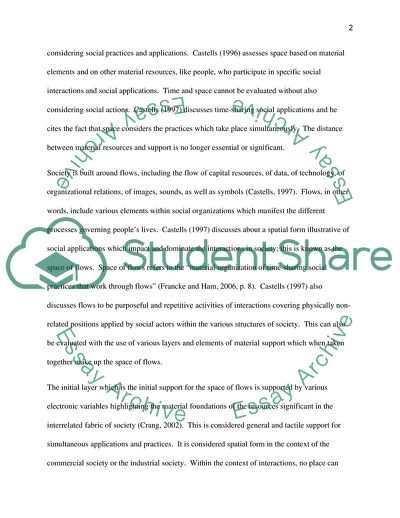Cite this document
(What does Castells Mean by the Space of Flows Assignment Example | Topics and Well Written Essays - 2750 words, n.d.)
What does Castells Mean by the Space of Flows Assignment Example | Topics and Well Written Essays - 2750 words. https://studentshare.org/journalism-communication/1796447-whatdoes-castells-mean-bythe-space-of-flows-and-what-relevance-might-this-idea-have-for-processes-of-globalisation-develop-an-example-to-illustrate-your-argument
What does Castells Mean by the Space of Flows Assignment Example | Topics and Well Written Essays - 2750 words. https://studentshare.org/journalism-communication/1796447-whatdoes-castells-mean-bythe-space-of-flows-and-what-relevance-might-this-idea-have-for-processes-of-globalisation-develop-an-example-to-illustrate-your-argument
(What Does Castells Mean by the Space of Flows Assignment Example | Topics and Well Written Essays - 2750 Words)
What Does Castells Mean by the Space of Flows Assignment Example | Topics and Well Written Essays - 2750 Words. https://studentshare.org/journalism-communication/1796447-whatdoes-castells-mean-bythe-space-of-flows-and-what-relevance-might-this-idea-have-for-processes-of-globalisation-develop-an-example-to-illustrate-your-argument.
What Does Castells Mean by the Space of Flows Assignment Example | Topics and Well Written Essays - 2750 Words. https://studentshare.org/journalism-communication/1796447-whatdoes-castells-mean-bythe-space-of-flows-and-what-relevance-might-this-idea-have-for-processes-of-globalisation-develop-an-example-to-illustrate-your-argument.
“What Does Castells Mean by the Space of Flows Assignment Example | Topics and Well Written Essays - 2750 Words”. https://studentshare.org/journalism-communication/1796447-whatdoes-castells-mean-bythe-space-of-flows-and-what-relevance-might-this-idea-have-for-processes-of-globalisation-develop-an-example-to-illustrate-your-argument.


